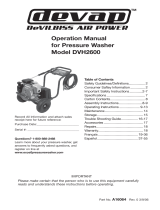
14- ENG
*NOTICE: The high pressure spray from your pressure washer is capable of
causing damage to surfaces such as wood, glass, automobile paint, auto striping
and trim, and delicate objects such as flowers and shrubs. Before spraying, check
the item to be cleaned to assure yourself that it is strong enough to resist damage
from the force of the spray.
CHANGING NOzzLES ON SpRAY W
AND
(FIG
.
8)
DANGER: Risk of fluid injection. Do not direct discharge stream toward
persons, unprotected skin, eyes or any pets or animals. Serious injury will
occur.
WARNING: Flying objects could cause risk of serious injury. Do not
attempt to change nozzles while pressure washer is running. Turn engine off
before changing nozzles.
1.
Pull quick-connect
coupler (E) back and insert nozzle (K).
8
K
E
2. Release quick-connect coupler and twist nozzle to make
sure it is secure in coupler.
WARNING: Flying object could cause risk of serious
injury. Ensure nozzle is completely inserted in quick-
connect socket and quick-connect collar is fully engaged
(forward) before squeezing gun trigger.
HO
W TO AppLY CHEMICALS/CLEANING SOL
v
ENTS (FIG. 6, 9)
Applying chemicals or cleaning solvents is a low pressure operation. NOTE: Use
only soaps and chemicals designed for pressure washer use. Do not use bleach.
To Apply Chemicals:
1.
Ensur
e detergent siphon hose (F, Figure 9) is attached
F
9
to barbed fitting location near high pressure hose
connection of pump as shown.
2.
Place other end of deter
gent siphon hose with
filter on it into container holding chemical/cleaning
solution. NOTE: For every 7 gallons of water pumped
1 gallon of chemical/cleaning solution will be used.
3. Install the black low pressure nozzle into the quick connect fitting of the spray
wand and rotate the Dial-N-Wash (M) to the MAX pressure setting as shown in
Figure 6. See How To Use Spray Wand paragraph in this section.
NOTE: To apply chemicals the black low pressure nozzle must be installed and
the Dial-N-Wash must be in the MAX pressure setting as shown in Figure 6.
4.
After use of chemicals, place deter
gent siphon hose into container of clean
water and draw clean water through chemical injection system to rinse system
thoroughly. If chemicals remain in the pump, it could be damaged. Pumps
damaged due to chemical residue will not be covered under warranty.
NOTE: Chemicals and soaps will not siphon if the black soap nozzle is not installed
on the spray wand.
STARTING (FIG. 10–13)
WARNING: To reduce the risk of injury, read the pressure washer instruction
manual and the engine instruction manual before starting pressure washer.




















